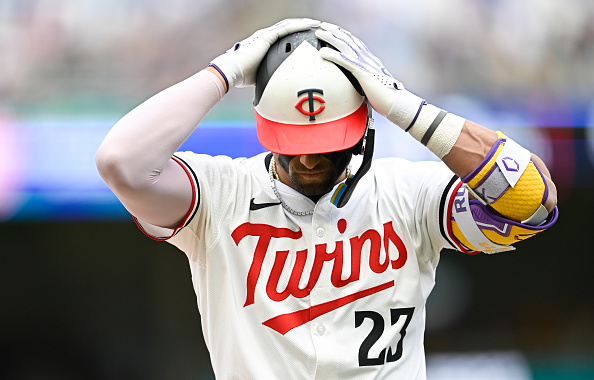The MLB Sophomore Jinx comes up around this time every season as the performance of many second-year players is not as good as their first seasons. Many people believe in this sensation associated with all professional sports, but none more than professional baseball. The phenomenon suggests that athletes who often perform remarkably well in their first MLB season rarely do as well in their sophomore (second) season.
Referred to as a Slump
Over the years, we have seen some players flash their potential as rookies, showcasing their talent for fans and the organization. The expectation to produce again the following year is high. However, in their second seasons, some recede into insignificance — often described as a “slump.”
Hitting Slump
While people talk about the “sophomore slump” — that the player just isn’t doing well — reasons can vary and the player may not be “slumping” at all, but rather in a learning stage. On the offensive side, new players often perform well because they can take advantage of pitchers who have never faced them. Pitchers learn to adjust to hitters after facing them a few times. The “slump” sets in once pitchers start making effective adjustments.
Hitters must make the same types of changes, adjusting to new pitches being thrown, as well as pitch locations. They no longer have an upper hand because there are more scouting reports and videos readily available for pitchers to review and make adjustments. Now, they’re up against pitching that knows them and their abilities better.
And it’s not always physical adjustments that need to be made. Great rookie hitters may face increased pressure to perform after being so successful. This added pressure can result in performance apprehension, which affects their mental game. Overcoming the mental “slump” can be just as difficult.
Pitching Slump
The MLB Sophomore Jinx also happens to second-year pitchers. Hitters learn how to hit their pitches with the help of experience, scouting reports, and video. They now have to make adjustments to battle those hitters.
Sophomore slumps can also be attributed to arm fatigue; pitchers throw more innings in their rookie seasons than when they were in the minors. This could mean they’re not throwing as hard as they used to — or if they are throwing as hard, their performance might become lackluster. Again, adjustments need to be made so the strain they’re putting on their arms doesn’t overwhelm their play.
They also face the mental aspect. It’s easy to let a few bad outings affect your mental game. Breaking out of a certain mindset can be hard on new players who don’t have vast experience of the normal ups and downs of the game.
5) Tanner Bibee shut down one of the best offences in baseball as he lowered his 4-Seam usage and increased his slider usage
His slider is his best offering, and he did a better job at avoiding the heart of the zone than prior starts
Great execution all around from him
5/5 pic.twitter.com/dXopsCvHgt
— Thomas Nestico (@TJStats) April 28, 2024
MLB Sophomore Jinx Doesn’t Last
For some players, the MLB Sophomore Jinx normally does not last a full season. Whether they are a pitcher or hitter, with the help of watching videos and listening to their coaches, second-year players can usually adjust and have a good season. Sometimes, it is just a matter of overcoming nerves from trying to be better than the previous season and settling down as soon as they get a few games under their belts.
Sophomores Can Bounce Back
Players certainly bounce back from sophomore slumps. Gary Carter was an All-Star in his rookie season. He hit 17 home runs with a .270 batting average. He finishes second in voting for 1975 National League Rookie of the Year. The next season, he hit only .219 in 91 games. However, he bounced back and had a Hall of Fame career.
Troy Tulowitzki is another player who endured the MLB Sophomore Jinx. He finished second in Rookie of the Year voting in 2007 when he hit .291 with 24 home runs. In 2008, he fell into a “slump,” hitting .263 with only eight home runs. Like Carter, he rebounded and had a solid career. He will appear on the 2025 Hall of Fame ballot.
Mike Trout
The MLB Sophomore Jinx could have happened to Mike Trout. After winning the Rookie of the Year in 2012 with a .326 average and 30 home runs, he opened the 2013 season hitting .261 with two home runs in April. However, after working on his plate discipline and pitch selection, he rebounded and posted great numbers. He finished the season with a .323 average and led the league in runs scored and walks, all while hitting 27 home runs and driving in 97 runs.
Mike Trout had surgery to repair his torn meniscus and the Angels don’t know how long he’s going to be out for.
So today, Zach Neto showed some love to Mike Trout by wearing his shirt to warm up. I love this 😭❤️ pic.twitter.com/UZ19GikoKj
— Baseball King (@BasebaIlKing) May 1, 2024
Skill in Baseball
There are plenty of examples of players experiencing sophomore slumps and bouncing right back. As we know, there is skill involved in baseball, but there is also luck. Hitters are trying to find out what type of pitch will be thrown. Pitchers have to decide the best pitch to challenge a hitter.
There is no way to predict how and why some players go through the MLB Sophomore Jinx. Only time will tell how each player handles it. If they can make the proper adjustments, they may not have a slump at all, but they know it can be done.
Main Image Credit:







